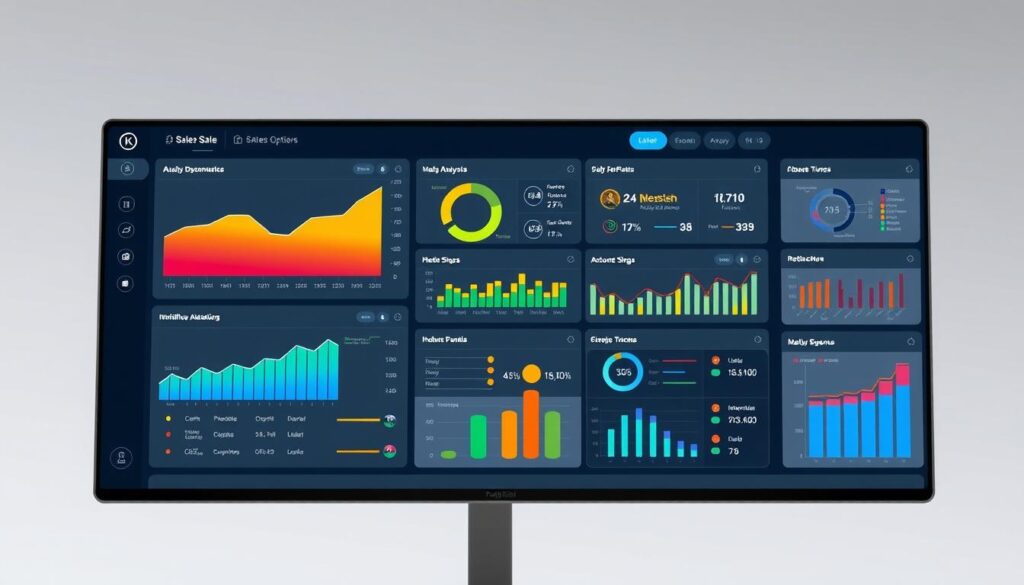In today’s digital world, sales automation solutions are changing how companies create their sales strategies. Many sales and operation tasks are ready for automation. This can lead to better efficiency and a rise in revenue for those who act early. Even though research shows that about a third of sales tasks could be automated, few companies are using these opportunities.
By adding advanced sales technology solutions to their daily tasks, businesses can enjoy many benefits. These include cutting costs in sales and greatly increasing productivity. Some early users report a 10 to 15 percent better efficiency and a sales boost of up to 10 percent. This journey to automation is not just about quick wins. It’s about setting up for success in the long run.
Now is a big time for changes in sales, with automation at the core. The numbers speak for themselves: cutting down the time it takes to process orders and making customers happier are just the start. Tools like robotics process automation (RPA) and virtual agents save time and improve how customers feel about the service they receive.
Key Takeaways
- Sales automation is a untapped goldmine, with a third of tasks automatable.
- Pioneers in sales automation report up to a 10% increase in sales and reduced costs.
- Automation drastically reduces order processing time, enhancing operational efficiency.
- Change management is pivotal in the implementation journey, deserving over half of the investment budget.
- Tools with AI, lead management, and analytics features are key in sales automation.
- Generative AI is unlocking new horizons in automation, especially in areas demanding natural language understanding.
What Are Sales Automation Solutions?
In today’s sales world, sales automation software is key. It makes the whole sales process easier, from getting leads to closing sales. This boosts productivity and results.
Definition and Key Features
Sales automation software is built to do sales tasks automatically. This makes sales teams work better and more efficiently. Key features include sorting potential customers, integrating email marketing, and analyzing data in real time.
With CRM automation, the system looks at customer info by itself. This helps sales folks know who to talk to first. Studies show that automation could help sales efforts a lot, making things run smoother.
Importance in Today’s Sales Landscape
Nowadays, making sales feels personalized and quick, thanks to sales automation software. With AI, such as generative AI, sales ways are changing. Automation means saving about 4.5 hours a week by doing things like writing emails on its own.
Another key part is sales workflow automation syncing data fast. This keeps customer info updated everywhere, which is super important for talking to customers well.
Efficient sales automation is great for managing contacts and leads. It helps predict sales and manage resources better, which really helps sales results. Let’s dive into some of its best features:
| Feature | Benefit |
|---|---|
| Automated Lead Scoring | Helps focus on leads that could really pay off |
| Real-Time Analytics | Gives quick insights to act on |
| AI-Driven Forecasting | Makes better guesses on future sales |
| Email Automation | Makes keeping in touch easier |
By using these tools, businesses can make their sales better and improve customer experience. This leads to happier customers and more loyalty. It lets the sales team focus on building strong relationships with clients, pushing growth and profits.
Benefits of Implementing Sales Automation
Businesses today aim to get better at what they do and connect deeper with customers. To do this, putting in place sales automation platforms is key. These tools make selling faster, boost the work sales teams do, and help create stronger customer ties.
Increased Efficiency and Productity
Introducing efficient sales automation cuts back time on routine tasks. This lets sales pros focus more on selling. With automation, tasks like making proposals and responding to RFPs happen quicker and with fewer mistakes. This boosts productivity and shortens sales cycles. Salesforce notes that automation can free up to 28% of a sales team’s time, leading to higher sales.
Enhanced Customer Relationship Management
CRM automation tools empower businesses to handle customer relationships better. These tools keep customer details up-to-date, helping sales reps stay informed. This aids in personalizing customer interactions, greatly improving satisfaction and loyalty.

Improved Data Analysis and Reporting
With sales automation software, gathering and analyzing sales data becomes easy. It ensures data is always current, giving sales teams insights fast. Plus, it offers powerful analytics and tailored reports. These features help in making smart, data-based sales strategies to win over and keep customers.
| Feature | Benefit |
|---|---|
| Automated Prospecting | Saves time and targets customers with precision, boosting engagement rates |
| Lead Scoring | Focuses efforts on most promising leads, increasing conversion rates |
| Email Drip Campaigns | Automates customer engagement, enhancing relationship building |
| Sales Process Automation | Ensures consistent communication and timely follow-ups within sales pipelines |
| Data Analytics and Reporting | Offers real-time performance tracking and actionable insights |
Popular Sales Automation Tools
Today, lots of sales tech solutions are out there. Finding the best sales automation platforms matters a lot. It’s key for boosting your business’s efficiency.
Overview of Leading Solutions
The digital marketplace is full of strong sales automation tools. These tools meet different needs. For instance, Salesforce is great at managing customer data. It makes the sales process more efficient. Dealfront focuses on identifying B2B customers. It can pull direct contact details and analyze buying intentions. This makes talking to prospects easier.
Each tool offers something special. Lead scoring, tracking engagement, and advanced reports are just some features. These features help increase revenue by automating key sales tasks.

Comparison of Features and Pricing
Picking the right sales technology needs a careful look at features and their prices. SalesBlink is good for reaching out across multiple channels. SalesHandy stands out for its email tracking and team features. Instantly and Klenty are noted for handling lots of cold emails and CRM integration.
The cost differs based on features, users, and extra services. When choosing, think about how easy it is to integrate, if it can scale, and the analytics it provides.
These platforms are made to help sales teams work less by hand and do more. They’re super helpful for any business that wants to use top sales automation platforms. The best choice fits with what a company does now and can adapt as the company grows.
Best Practices for Implementing Sales Automation
Choosing the right sales automation solutions is key. It’s also vital to blend them smoothly into your company. This strategy boosts efficiency. It lets the sales team focus on closing deals and improving customer connections.
Step-by-Step Guide for Integration
First, examine your current sales routines closely. Identify where automation can save time or boost results. Then, make these processes consistent for easier automation.
Start implementing on a small scale. This lets your team get used to new methods in a manageable setting. A trial phase is essential to adjust the system using real feedback. After proving its worth, extend it across the sales department. This ensures everyone is in tune with the automation.
- Leveraging CRM automation keeps sales reps focused on customer talks.
- Using email automation keeps engagement high with less work.
- Lead management automation helps focus on promising prospects.
- Automating daily chores, like inputting data and scheduling, increases productivity.
Training Your Sales Team
For sales automation solutions to work, your team must know them well. Offer thorough training, regular updates, and ongoing support. A culture that adapts to new tech keeps your team flexible.
Teach your team to use automated insights for better lead and client interactions. Link these habits to their performance goals to boost their enthusiasm for these tools.
Lastly, hold frequent feedback meetings to hear from the sales team. This lets you improve the automation tools continuously. By doing this, the sales automation platforms stay aligned with your company’s aims and market changes.
Measuring the Success of Sales Automation Solutions
When adding CRM automation tools to a business, assessing their impact is crucial. This involves looking at sales performance from various angles. A solid set of Key Performance Indicators (KPIs) helps understand how well automation works. These indicators tell the story of success, showing where a business is strong and where it needs to improve.
Key Performance Indicators (KPIs)
Metrics like Website Conversion Rates and Lead Velocity measure how well a sales funnel works with CRM tools. Sales Cycle Length and Average Deal Size show the efficiency improvements from automation. Meanwhile, Customer Lifetime Value (CLV) and Net Promoter Score (NPS) indicate the effects on customer relationships over time. Each KPI, from Cost Per Lead (CPL) to Conversion Rate from Lead to MQL, narrates the change in operations. It shows how automation strategies enhance growth and customer engagement.
Continuous Improvement and Adaptation
But, tracking KPIs is just the beginning. It’s part of an ongoing process that encourages constant enhancement and change. With AI and machine learning, sales automation tools get better at forecasting and personalizing customer interactions. It’s vital to regularly reassess and adjust strategies to stay ahead of competition and meet changing customer needs. By closely monitoring and tweaking automation processes, sales teams can seize control. They can guide sales performance towards long-lasting success.
FAQ
What Exactly Are Sales Automation Solutions?
Sales automation solutions mix software and tools. They automate parts of the sales process, like lead generation to customer retention. They include lead tracking, automated messages, deal predicting, and CRM system integration.
How Important Are Sales Automation Solutions in Today’s Market?
Sales automation solutions are vital in today’s fast sales world. They let businesses do more tasks accurately with fewer people. They help manage relationships better and use data to boost sales and customer experiences.
What Benefits Can a Company Expect from Implementing Sales Automation?
With sales automation, companies gain efficiency and productivity. Sales teams focus more on selling, not admin tasks. It brings better customer management, personalized talks, and data analysis. This leads to smarter choices.
What Are Some of the Popular Sales Automation Tools in the Market?
Many sales automation tools fit different needs. Popular ones include CRM systems, email marketing automation, and analytics tools. These automate sales forecasting and reports.
How Should a Business Approach the Comparison of Different Sales Automation Platforms?
Businesses should look at their needs like desired features and easy system integration. Compare each platform’s pros and cons with trials or demos. This helps find the best match.
What Is a Step-by-Step Guide for Integrating Sales Automation into a Business?
Integrating sales automation starts with understanding business needs. Then pick a platform, standardize sales processes, set up the system, train the team, and keep optimizing the system.
Why Is Training Important During the Implementation of Sales Automation Platforms?
Training is key for teams to fully use the new tools. It helps in engaging better with customers, streamlining sales processes, and boosting sales performance.
What Metrics Are Used to Measure the Success of Sales Automation Solutions?
To measure sales automation success, look at sales productivity like time saved and tasks automated. Also, check sales performance metrics like conversion rates, cost per customer, deal size, and revenue growth.
How Can a Business Ensure Continuous Improvement in Their Automated Sales Processes?
For ongoing improvement, regularly review your automation strategy. Keep up with tech advancements, train your team on latest features, and adjust based on feedback. This refines the sales processes even more.



